|
October 1969 Radio-Electronics
 [Table of Contents] [Table of Contents]
Wax nostalgic about and learn from the history of early electronics.
See articles from Radio-Electronics,
published 1930-1988. All copyrights hereby acknowledged.
|
It is hard to imagine anyone
who has not heard of the Dolby noise reduction process, even if he/she has no idea
what it is. Dr. Ray Dolby
developed his process in 1965, although it was not patented until 1969 - the year
this article appeared in Radio-Electronics magazine. At the time, "Dolbyized"
audio systems were not available in the consumer marketplace because the price was
prohibitively high - $1,495* for a basic A301 system. Only about 25 units per
month were being produced, primarily for recording studios and reproduction factories.
Dolby's magic that can reduce noise by 15 dB works on the
companding
(portmanteau of compression and expansion) principle, thereby eliminating or greatly
suppressing the discernable "hiss." Dolby B is still the most common version
in use after nearly half a century.
* $1,495 in 1969 is the equivalent of $12,229 in 2023 money per the BLS
Inflation Calculator.
Other Dolby articles from vintage electronics magazines include: "The Dolby System
- How it Works" (October 1969 Radio-Electronics), "All About Dolby"
(June 1971 Radio-Electronics), "The Dolby Technique for Reducing Noise" (August 1972 Popular
Electronics), "The Dolby Noise-Reduction System" (May 1969 Electronics World).
The Dolby System - How it Works
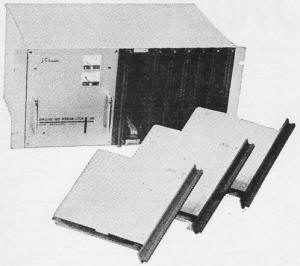
Rack-mounted A301 uses 4 plug-in PC cards for bands in identical
stereo channels.
Taking the hiss from hi-fi tape recording.
by Walter G. Salm
Rapidly gaining acceptance by major recording companies, the Dolby system cuts
tape hiss 10-15 dB and reduces print - through 10 dB. Although you need
a 'black box' to hear a Dolbyized tape, prerecorded tapes are sounding better than
ever.
There's an ever-present annoyance with tape recordings. It's called tape noise.
It takes various forms, with hiss being the most readily apparent to the listener.
The other noises are tape recorder rumble and scrape, and that ever-present gremlin,
print-through.
These noises occur at the tape recorder as the recording is being made-or in
the case of print-through, after the tape is made. The noise isn't present in the
signal coming to the tape equipment from the mixing console; up to that point, the
signal's nice and clean.
Various methods have been tried to eliminate noise, hiss in particular - exotic
filtering systems, compression or expansion amplifiers, and a variety of related
devices. Manufacturers frequently announce a "totally new" noise-reduction system.
Most of these systems work up to a point, but many inject "swishing" noises into
the recording because of the compressor amplifier's relatively slow attack time.
It can't react fast enough to the rapidly changing audio dynamics of the input.
Low-Passage Noise
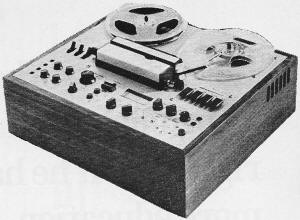
A tape deck using one Dolby frequency band to cut tape hiss is
manufactured by KLH.
Where are these tape noises most noticeable? You don't need a cram course in
audio to know - it's always in the low-level music passages. In the loud sections
of a recording, there are plenty of desirable decibels to mask any intruding noise,
but hit that pianissimo section and suddenly the hiss comes storming through, along
with print, scrape and rumble. If the intrusive noise could be drastically reduced
in these low passages, so the reasoning goes, then the overall noise level would
be reduced.
Working on this premise, Dr. Ray Dolby developed his A301 noise-reduction system,
and started manufacturing it in England a couple of years ago. This system is inserted
in the signal path between the console and the tape equipment during the taping
session. During playback, the tape's signal must pass through the A301 again on
its way to the amplifier. A Dolbyized tape cannot be played back without the benefit
of reprocessing by the A301.
The A301 itself is actually a dual unit - two systems for two-channel stereo.
The same stereo unit that's used for recording can be used for playback, simply
by changing the connectors and flipping switches. The basic A301 is tagged at $1495,
so it's not a toy that the casual home recording enthusiast can buy for his amusement.
Tape-to-tape dubs do not require further Dolbyized (as long as tape-to-tape equalization
remains the same).
The overall effect is to reduce hiss and other noise factors by 10 to 15 dB!
A listening test demonstrates its effectiveness graphically. A-B comparison with
and without the A301 in the system makes one thing immediately apparent - with the
Dolby, there's absolutely no discernible hiss, not one little bit of it.
As a starting point, the Dolby system divides the audio spectrum into four frequency
bands: 0-80 Hz, 80-3000 Hz, 3-9 kHz and 9 kHz to the upper limit
of the audio spectrum. Crossover transitions between these bands are exceptionally
smooth, with no measurable discontinuities or attenuation.
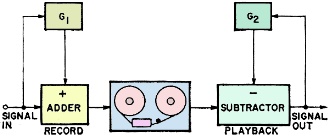
Fig. 1 - System's feed-back loops provide necessary expansion
and compression to override background noise.
In the process of making a recording, low-level signals are boosted before reaching
the tape recorder and compressed by an identical amount in playback. The expansion/compression
moves the low-level signal up at least 10 dB. This 100 dB edge over intrusive
noise is maintained during expansion. The net result is that noise level is at least
10 dB lower than without the Dolby process.
In his description to the Audio Engineering Society in 1967, Dolby characterized
the basic elements of his black box as shown in Fig. 1. G1 and G2
are identical signal multipliers controlled by the signal's amplitude, frequency
and dynamic properties. During recording, network G1 passes low-level
signals to the adder, which adds a component (signal expansion) to the signal on
its way to the recorder. During playback, G2 p passes low-level components
to the subtractor, which partially cancels these noise elements in the signal. G2
also partially cancels low-level (desirable) signal components, thus offsetting
(compressing) the signal that had been partially expanded through G1's
action.
Mathematically, Dolby explains that if the input to the recording processor is
x (some function of time), the signal in the channel is y, and the output signal
from the reproducing processor is z, the condition is described as:
y = [1 + G1 (x)] x
(1)
and
z = y - zG2(z) or
z = { 1/[1 + G2(z)] }y
(2)
Combining equations (1) and (2):
z = { [1 + G1(x)] / [1 + G2(z)] }x.
(3)
Solving these equations, G1 = G2 and z = x. These solutions
show that the output signal will equal the input signal if G1 and G2
are the same, provided G(z) does not become -1 (no oscillation) and the functions
in (1) and (2) are continuous and single-valued - in other words, no tracking ambiguity.
It looks fine on paper, and the proof of the math is in the listening: it works.
In fact, it works so well that, in A-B tests, the listener can't help but wonder
if someone hasn't jacked up the hiss level in the unprocessed tape - the difference
is that marked and apparent. But no, there's been no monkeying with the tape - just
the normal amount of dubbing and processing.
Recording Companies "Dolbyize"
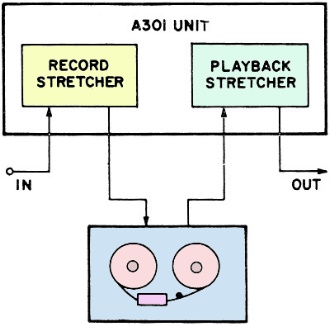
Identical A301 halves can serve for stereo or a record-playback
monitor.
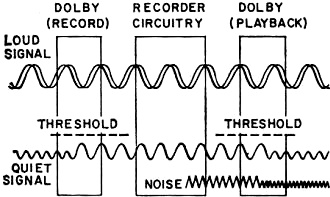
A301 boosts low-level audio before recording, compressing it
in playback.
First to recognize the value of this new system have been the major recording
companies. Since every recording-tape and disc - must first go through several generations
of tape dubs, eliminating the noise that creeps into these transfers and mixes makes
the final, non-Dolbyized product that much cleaner.
True, the prerecorded tape purchased by the consumer has its own hiss and other
noises, but all the preceding noise in the production chain has been eliminated.
Thus, instead of a noise level as high as 10 to 14 dB, the finished product
may have a noise level of only 3 dB - a more-than-tolerable level. Tapes commercially
produced this way sound so good, in fact, that duplicators such as Ampex have started
touting their remarkably noise-free quality. Although discs have had very low noise
levels for some years, those pressed from Dolbyized master tapes sound notably quieter
and cleaner.
But it's no simple matter for a recording company to Dolbyize. First, there's
the very limited production of A301's. Ray Dolby has a baker's dozen technicians
in his London shop lovingly hand-crafting his A301's with a Rolls-Royce kind of
zeal and perfectionism. Total production capacity now is about 25 units per month,
and a large recording company may require at least that many units to handle its
manifold operations.
Dolby won't be hurried. He's a perfectionist, and he sees this perfectionism
as part of his stock in trade. A brilliant designer, he was largely responsible
for the development of the electronic circuitry for the original Ampex video tape
recorders while he was still a teenage undergraduate at Stanford University. He
received a PhD in physics from Cambridge in 1961.
Dolby at Popular Prices
The price picture isn't all that gloomy. There's one way the home recording enthusiast
can get his feet wet with the Dolby system. It's called the KLH recorder. This is
KLH's first entry in the tape field, and it's a lulu. In addition to a host of professional-caliber
specs, the deck has a built-in Dolby system - and all for $600. [A recently introduced
KLH Dolby tape deck sells for less than half this price.]
Actually, it's not a full-blown Dolby. The machine just uses the third frequency
band since this is where most hiss occurs, The KLH Dolby produces tapes recorded
at 3-3/4 ips with no higher noise level than tapes recorded at 15 ips without Dolby
treatment.
The KLH Dolby does a dandy job of killing hiss, and could be a very worthwhile
investment for the serious recording hobbyist who wants to maintain the best possible
quality in his home recordings. But what happens when he wants to dub and maintain
noise free tapes? Buy two KLH recorders? This might be what the Cambridge whiz-kids
had in mind, especially since they have an exclusive license to use the Dolby circuit
for manufacturing in the US.
The System's Noncompatibility
The Dolby system isn't a panacea. It can't clean up already recorded tapes. Its
function is to process the sound going onto the tape, and then to reprocess it as
it leaves the tape. It just won't clean up noise already indelibly etched in those
oxide particles.
Another problem: in today's ever-expanding tape channel capabilities, the A301's
price and relative unavailability makes it impossible to use with the 8- and 16-channel
audio mastering that is becoming more and more popular. This might involve having
as many as 16 units in a single recording studio control room for making just one
master tape. Fortunately, such multitrack originals are mostly used for "Acid" rock
and other popular sounds which don't make very critical demands so far as recorded
noise levels are concerned. It's in the realm of the serious recording - which is
usually taped in old-fashioned, two-channel stereo - that the Dolby system can really
come into its own.
Another problematical restriction: Dolbyized tapes simply can't be played back
on an ordinary tape system. The A301 must be in there to expand in the right places.
Without it, the dynamics and recorded sound in general will come out sounding pretty
weird. But in this era of electronic music and all of its strangeness to our more
conventional ears, this may well open the door to a new avenue of experimentation
with electronically generated musical effects. The engineer (or musician?) may play
with a console that controls the amount of Dolby expansion to be imposed on a Dolbyized
tape master.
And what about that A301? It's just a black box with some connectors on it. No
knobs to twiddle; no meters to watch: no circuit failures to keep the service techs
out of mischief. It's downright maddening! No knobs; really, Dr. Dolby!
Posted August 11, 2023
(updated from original
post on 11/28/2018)
|














